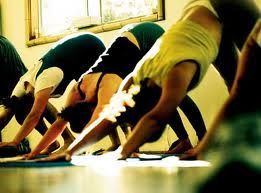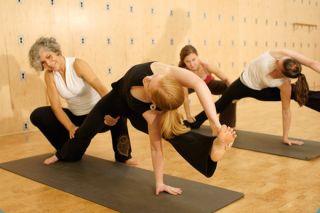Therapy
6 Steps For Finding the Right Yoga Practice
You don’t have to be passed out on your yoga mat for a healthy practice.
Posted August 29, 2012
Therapy is a process. Effective therapy is an active process. Rarely do the 45-50 minutes spent in a therapist’s office amount to an automatic resolution of concerns and miraculous solution to all problems. If this were the case, with the magical swish of a wand we could cure all and any ailments that walked through our doors.
In previous articles, I’ve discussed the foundations for solid mental health (for article see here), as well as ways that technological tools can help keep us accountable (see article here). There are also many ancient Eastern practices that may provide a host of benefits. Namely, I’m talking about yoga.
According to information compiled by Trisha Lamb and the International Association of Yoga Therapists, the health benefits of yoga include psychological, physiological, and biochemical effects. Psychological benefits include: a decrease in anxiety and depression; mood improvement; increase in social adjustment, self-acceptance and self-actualization; decreased hostility; and an increase in subjective well-being (happiness). Cognitive effects include improvement in attention, memory, and concentration. Physiological effects also abound and include: improved sleep; decrease in pain; improved cardiovascular efficiency; energy level increase; and weight loss.
While yoga classes and studios have become much more mainstream in the last couple of decades, the popularity of the practice has also in some ways altered its origins. Many former aerobics and pilates instructors now teach yoga without any formal training in the practice. Others fuse yoga with intense core workouts and boast “power” yoga classes that will make you break a sweat. And for those who really enjoying getting drenched and/or sweltering conditions, they will practice bikram or “hot” yoga in rooms with temperatures around 100 degrees Fahrenheit and around 40% humidity. Granted, for many this can be exactly what they are looking for in a yoga practice. But for yoga to be therapeutic or otherwise beneficial, such intensity is hardly needed.
The range of yoga styles and its esoteric lexicon (chakras, asanas, pranayma, etc.) has had the unfortunate effect of scaring away many from a practice that could markedly improve their overall health and quality of life. The Mayo Clinic provides a list of guidelines to consider when selecting a yoga class. Certainly if health concerns are present, consulting with a physician would be necessary prior to beginning a practice. Below, I list a few elements to consider for establishing a practice that can enhance overall well-being as well as therapy process.
1) Be kind

The idea of self-compassion and kindness to one’s entire self and body is one that we struggle with globally. Many times we are too harsh and critical of ourselves, and this seeps into other areas of our lives. For example, many times I’ve had clients discuss the idea of starting a yoga practice. After years of being inactive, they select the most physically challenging class and are quick to judge themselves when they fall short of their own expectations. So pick a class that fits your needs, and adjust accordingly. I’ve most often appreciated yoga instructors that truly cater to the needs of beginners. Though many will say they allow beginners into their classes, I’ve seen students unfamiliar with terminology and poses struggle and never return to classes. So even if your instructor doesn’t say certain poses are optional, or that you may take a break, allow yourself to rest between poses if needed. There is no need to struggle.
2) Start slow

Know that it’s ok to begin with something “easy.” The best yoga class I ever took was freshman year of college. It was called “gentle yoga fitness” and was co-sponsored with a local senior citizen’s center. It was slow, gentle, and the most relaxing yoga class I’ve ever taken. Inhales and exhales were expertly coordinated with every one of our yoga poses, so we could actually see the improvement each time we came in and out of a pose. Each time, we stretched just a tiny bit further and deeper, and it was amazing to see the improvement in just a few breaths. As such, more meditative and breath-centered yoga practices could be ideal for beginners. After all, the goal per se may not be a total body workout but may be simpler such as relaxation or light stretching.
3) Pick a small class

Though community classes are typically the most financially accessible, they are usually the most packed as well. For starters, look up the background on your yoga instructor online to learn more about their training, and if possible pick a small class. This can lead to much more one-on-one instruction as well as poses tailored to meet your needs. Good yoga instructors will often ask if you have any physical restrictions, have any requests, and will take the time to adjust your pose to keep you from injuring yourself.
Having been in larger classes crammed with students, I’ve often found several themes: 1) instructors don’t always have the time (or space) to walk around and adjust each student individually; 2) instructors may not offer pose modifications that can make the pose more or less challenging depending upon the student’s level. For example, many poses can be made less strenuous by enlisting a wall as a stable agent to help with balance. I’ve often found that in larger courses many students have some experience with yoga, and so the challenge level is bumped up many more notches than a beginner would appreciate.
4) Props are fun!

Some of the best yoga classes I’ve taken have made innovative and effective use of a number of props: yoga blocks, blankets, and straps. In one fun class, they had us lay down in corpse pose with our body weight supported by only a few blocks, which made us feel like we were floating. Other times, blankets may be used to apply gentle pressure to open up tight areas, or may be rolled up into logs to help open up the shoulders. These poses that encourage gently opening and relaxing of body parts are sometimes the most therapeutic as well. Many times, a series of poses may open up regions that traditionally hold tension such as the shoulders and back. After doing them in succession, your body may hold little hope of storing tension there by the end of class.
5) Play the field, or rather the studio

Don’t be afraid to try different classes, studios, and instructors. Shop around until you find something that fits your needs. Every time I move to a new area, I struggle to find yoga classes quite like the ones I took nearly a decade ago. These days, every studio I walk into seem to be power and core-driven. However, that is not to say more meditative and breath-centered studios do not exist. Also, don’t be shy about approaching instructors frankly with questions and concerns. My favorite instructors have been the ones that have emphasized yoga is the one place where you are not competing against anyone, including yourself. Ideally, a yoga instructor will challenge you, but will also not push you to go further than you are comfortable. Some instructors include poses such as a shoulder stand as standard practice, while others consider it to be a more advanced pose. Figuring out the type of instructor and studio that works for you is essential. And of course, word of mouth can be a great way of finding good classes as well.
6) Think of yoga as play

Unlike a kick-boxing class, yoga can really be fun and playful. Bring a buddy and make it a yoga date. One of my good friends and I once tried a Friday night candlelight yoga class that brought on bouts of giggles but also a good workout. Certainly for the unaccustomed, many aspects of yoga may seem downright strange. The first time I ever had to inhale cat and exhale dog, my exhale came out as a burst of laughter. I have been to classes with chanting and with interesting nostril sealing breath techniques. I’ve also nearly suffocated from the strong scent of incense in other classes. In the end, it challenges you to step outside of your comfort zone and to try something new. For some yoga may be deeply spiritual, while for others it may be part of their regimen to obtain washboard abs.
Therapeutically, I have seen the benefits reaped by my clients who practice yoga while in therapy. For some, life circumstances have made it so that their former practice has dropped to the wayside, and for others it is a new experience entirely. I have known some yoga instructors to ask students to set aside an intention for each practice. Others have read spiritual or inspiring passages and quotes prior to the final resting posture. At times I have thought these instructors are providing to students much of what we therapists hope to give to our clients—peace, awareness, self-compassion, contentment, and balance.
Follow me on Twitter at MillenialMedia. Namaste.




